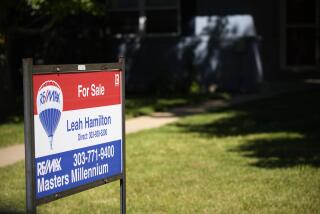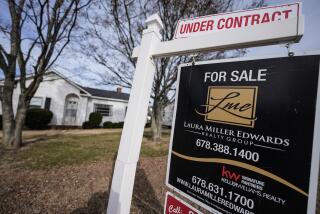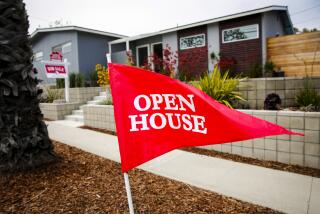Cutting Costs or Corners?
If you’re paying a real estate agent a 6% commission to sell your house, you’re offering too much. Five percent? Still too high. And if you’re parting with (shudder) 7% of the sales price, you might as well tattoo “chump” on your forehead.
Or so the growing legion of discount real estate brokerages, which promise to sell your home for fees ranging from 1% to 4 1/2% of the selling price, would have you believe.
Discount brokerages aren’t new, a fact that any conventional real estate agent will quickly point out. Help-U-Sell, for instance, which bases its commission on the number of “services” it provides its clients, has been around since 1976.
And because commissions are always negotiable, savvy sellers can often talk agents down from their customary fees. Traditionally, conventional brokerages such as Century 21, Coldwell Banker and Re/Max charge commissions ranging from 5% to 7%, with the fee split evenly between the buyer’s and seller’s agents.
But there’s nervous chatter among real estate professionals these days about a potential decline in commissions. The Internet has made information previously available only to licensed agents, such as homes for sale in a specific city or neighborhood, accessible to anyone with a PC and modem. As a result, clients are doing much of the selling-and-buying research themselves and seeking reduced commissions in return.
The lure of a discount agent is particularly enticing in Southern California’s overheated real estate market, where a home can sell in one day. Some sellers wonder why they paid 6% for what seems to them like so little work.
“I sold my house for $825,000, and when you talk about 6% of that, that’s too much,” said Danny Bautista, who paid CataList Homes, a low-commission brokerage in the South Bay, a 3% total commission to sell his Palos Verdes Peninsula home. Because a standard residential real estate sale in the South Bay involves a 5% commission, Bautista saved $16,500.
Internet-based discounters such as eRealty.com and zipRealty offer to sell homes at a percentage point or two below the going rate in specific U.S. markets, including Southern California. And CataList Homes markets its services with billboards and other advertising that play off sellers’ distaste for paying customary commissions.
“Homes in the South Bay that would sell for $300,000 five years ago are now selling for $600,000,” said CataList Homes Chief Marketing Officer Michael Davin. “You wonder why agents, who were happy charging 5% five years ago, want 5% today.”
It gets even better (for sellers) and worse (for traditional real estate agents): Discounters say they offer the same services as the old guard--open houses, advertising, even posting on the multiple listing service, or MLS, a directory of local homes for sale that agents use to find properties for their clients.
Even on a moderately priced home, a reduced commission can mean huge savings for the seller. For instance, a 6% fee on a $300,000 home costs the seller $18,000, whereas a 3% commission cuts the fee to $9,000. The savings can make a difference for sellers who don’t have a lot of equity in their homes and need every dollar to put toward their next home purchase.
Conventional brokerages are typically dismissive of discounters, claiming reduced-fee agents offer fewer services and shortchange their clients by taking on more home listings than they can handle to compensate for the lower fees.
“They have to work on a volume basis, and when you do more volume, your service gets spread thin,” said Greg Whilden, a real estate broker at the Real Estate Group in Torrance.
However, Bautista believes the service he received from CataList Homes was “basically the same” as that provided by a conventional real estate agent.
But another CataList Homes customer, Lori Rubin of San Pedro, thought the agency cut corners when showing her $489,000 house, which didn’t sell after three months on the market.
CataList Homes offers a 1.5% fee to the buyer’s agent in a region where 2.5% is the norm. As a result, some sellers fear that South Bay agents may deliberately ignore CataList Homes’ listings.
To CataList Homes’ Davin, those fears are the result of rival agents trying to scare sellers into using a conventional agent. He said that 88% of CataList’s home sales involve buyers’ agents. “If they’re all boycotting our listings, how would we do business?” Davin asked rhetorically.
“People said [my home] would not be sold by other brokers, but I didn’t experience that,” Bautista said. “My house sold very quickly.”
Rubin, however, is convinced that CataList Homes’ reduced commission policy played a major role in the failed sale of her San Pedro home. “I was told that many brokers will not go out of their way to bring clients to a [CataList] home, knowing that their commission is going to be significantly smaller,” she said.
To keep peace among their fellow real estate agents, and to move their clients’ homes as quickly as possible, most discounters offer a standard 2.5% to 3% commission to buyers’ agents.
Mike Glickman, a discount Realtor based in Beverly Hills, also sells homes for a 3% commission. But he keeps just half a percent of that and gives 2.5% to the buyer’s agent.
“I work 35 to 40 communities [in Southern California], and in some of them you can offer less than 2 1/2%,” Glickman said. “But if you do so in some areas, you won’t have a broker look at the house.”
Some discounters promise to sell a home for 1%, but, in most cases, that involves a single agent who deals directly with a buyer or who manages the transaction for both parties. “We can’t post a home on the MLS and charge only 1% because you have to structure in the pay of the other agent,” said Cheryl Gober, president of RealEstateRebates.tv, a discount brokerage in San Diego.
Discounters cut fees in other ways too. For instance, Malibu-based eCondo.com has a flat-fee structure in which its largest commission is $10,000 (for sales above $1 million). And Dan Dobbs, a Realtor and mortgage broker in Orange County, will sell your home free provided you retain him as your agent on your purchase--at a standard 2.5% to 3% commission.
Many conventional real estate agents react to discounters with indifference. Corporate officials for Coldwell Banker and Re/Max declined The Times’ request for an interview, with a Coldwell Banker spokesman dismissing discount brokerages as “niche players.”
The niche label does have some merit. Roughly 2% of home sales nationwide are handled by discount brokerages, according to the National Assn. of Realtors. And even CataList Homes’ Davin said the market share for discounters has been less than 1% historically.
But many home sellers don’t factor in historical considerations when choosing an agent.
“The buying and selling public looks at the importance and value of a [real estate agent’s] work and probably thinks 6% is a little high,” said eRealty Chief Executive Russell Capper.
One thing is certain: In a hot real estate market, a reasonably priced home in good condition will sell fast.
“Whether they list it with the best real estate company in the world or with Aunt Suzie,” Glickman said, “the home’s going to sell in three days.”
*
Jeff Bertolucci, a former news editor for PC World, is a freelance writer in Agoura Hills.
More to Read
Inside the business of entertainment
The Wide Shot brings you news, analysis and insights on everything from streaming wars to production — and what it all means for the future.
You may occasionally receive promotional content from the Los Angeles Times.










